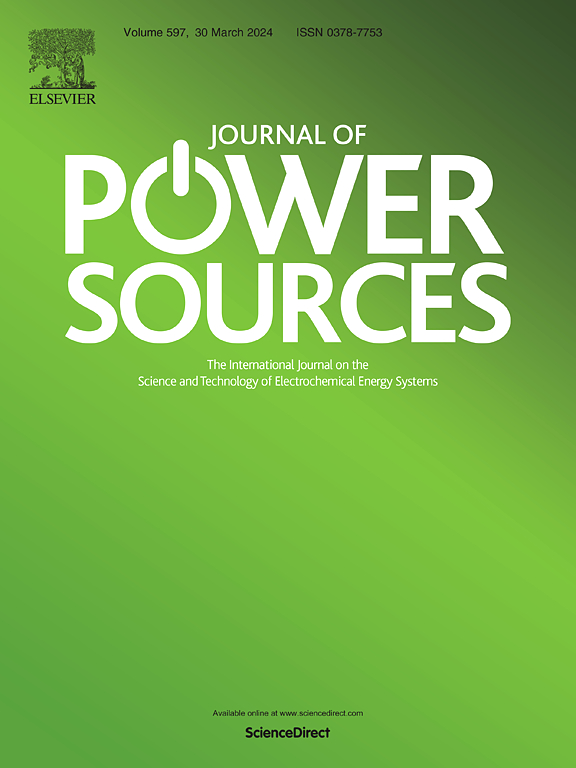Design and scaling hybrid hard carbon electrodes to balance energy and power performance in Sodium-ion batteries
IF 7.9
2区 工程技术
Q1 CHEMISTRY, PHYSICAL
引用次数: 0
Abstract
Achieving both high energy and power density in a single Sodium-ion battery system remains a major challenge, as conventional designs often trade one for the other. This study addresses this gap by introducing a hybrid hard carbon (HHC) strategy that blends micro and nano-sized hard carbon particles to optimize electrode structure and performance. By systematically tuning particle size ratios, the work demonstrates how key electrode parameters, such as porosity and tortuosity, directly influence initial Coulombic efficiency, rate capability, and long-term stability. Among the various configurations, the HHC5050 electrode (50 % microparticles and 50 % nanoparticles, ∼2.5 mg/cm2) offers a well-balanced profile, delivering excellent reversibility (∼87.7 % capacity retention after 500 cycles), and favorable ion transport (theoretical tortuosity ∼1.25; experimental ∼10.3). It maintains ∼171.6 mAh g−1 at 2C (∼54 % of the 0.1C capacity) and shows stable interfacial behavior confirmed by time-dependent electrochemical impedance and distribution of relaxation time analyses. When scaled to a high mass loading (∼13.6 mg/cm2), it retains ∼90 % of its initial capacity after 100 cycles with minimal performance loss. Importantly, the study bridges material-level optimization to practical implementation, demonstrating projected excellent full-cell performance with various cathodes. Paired with a Prussian blue analogue, the optimized HHC anode achieves projected energy densities of ∼453.2 Wh/kg (electrode level) and ∼175.8 Wh/kg (pouch cell level). These findings position the HHC5050 electrode as a viable and scalable anode design for future Sodium-ion batteries targeting mid-range electric vehicles and energy storage systems.
设计和缩放混合硬碳电极,以平衡钠离子电池的能量和功率性能
在单一钠离子电池系统中实现高能量和高功率密度仍然是一个主要挑战,因为传统的设计经常交换其中一个。本研究通过引入混合硬碳(HHC)策略来解决这一问题,该策略混合了微观和纳米尺寸的硬碳颗粒,以优化电极结构和性能。通过系统地调整粒度比,该工作证明了关键电极参数,如孔隙率和弯曲度,如何直接影响初始库仑效率、速率能力和长期稳定性。在各种配置中,HHC5050电极(50%微粒和50%纳米粒子,~ 2.5 mg/cm2)具有良好的平衡轮廓,具有出色的可逆性(500次循环后的容量保持率~ 87.7%)和有利的离子传输(理论扭曲度~ 1.25;实验10.3∼)。它在2C时保持~ 171.6 mAh g−1 (0.1C容量的~ 54%),并通过随时间变化的电化学阻抗和弛豫时间分布分析证实了其稳定的界面行为。当扩展到高质量负载(~ 13.6 mg/cm2)时,它在100次循环后保持其初始容量的~ 90%,性能损失最小。重要的是,该研究将材料级优化与实际应用相结合,展示了不同阴极的全电池性能。与普鲁士蓝类似物配对,优化的HHC阳极实现了约453.2 Wh/kg(电极水平)和约175.8 Wh/kg(袋状电池水平)的投射能量密度。这些发现将HHC5050电极定位为未来针对中程电动汽车和储能系统的钠离子电池的可行且可扩展的阳极设计。
本文章由计算机程序翻译,如有差异,请以英文原文为准。
求助全文
约1分钟内获得全文
求助全文
来源期刊

Journal of Power Sources
工程技术-电化学
CiteScore
16.40
自引率
6.50%
发文量
1249
审稿时长
36 days
期刊介绍:
The Journal of Power Sources is a publication catering to researchers and technologists interested in various aspects of the science, technology, and applications of electrochemical power sources. It covers original research and reviews on primary and secondary batteries, fuel cells, supercapacitors, and photo-electrochemical cells.
Topics considered include the research, development and applications of nanomaterials and novel componentry for these devices. Examples of applications of these electrochemical power sources include:
• Portable electronics
• Electric and Hybrid Electric Vehicles
• Uninterruptible Power Supply (UPS) systems
• Storage of renewable energy
• Satellites and deep space probes
• Boats and ships, drones and aircrafts
• Wearable energy storage systems
 求助内容:
求助内容: 应助结果提醒方式:
应助结果提醒方式:


